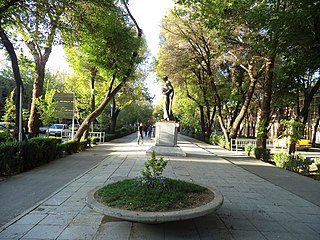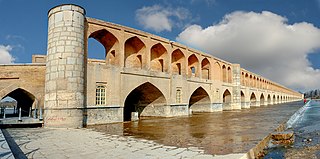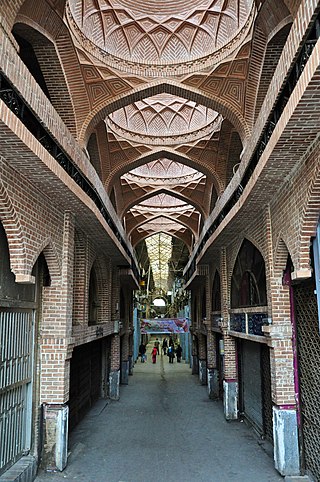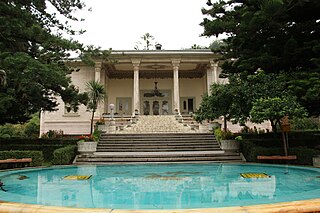The Persians are a Western Iranian ethnic group who comprise the majority of the population of Iran. They share a common cultural system and are native speakers of the Persian language as well as of the languages that are closely related to Persian.

Isfahan or Esfahan/Espahan is a major city in the Central District of Isfahan County, Isfahan province, Iran. It is the capital of the province, the county, and the district. It is located 440 kilometres south of Tehran. The city has a population of approximately 2,220,000, making it the third-most populous city in Iran, after Tehran and Mashhad, and the second-largest metropolitan area.

Tabriz is a city in the Central District of Tabriz County, in the East Azerbaijan province of northwestern Iran. It serves as capital of the province, the county, and the district. It is the sixth-most-populous city in Iran.

A dakhma, otherwise referred to as Tower of Silence, is a circular, raised structure built by Zoroastrians for excarnation, in order to avoid contamination of the soil and other natural elements by the decomposing dead bodies. Carrion birds, usually vultures and other scavengers, consume the flesh. Skeletal remains are gathered into a central pit where further weathering and continued breakdown occurs.

Ramsar is a city in the Central District of Ramsar County, Mazandaran province, Iran, serving as capital of both the county and the district.

Pāpak Fort or Babak Castle, ″Ghal’eh-e Bābak″ is a large citadel on the top of a mountain in the Arasbaran forests, 50 km from Ahar, one parasang from Ardabil, 6 km southwest of Kalibar City in northwestern Iran. According to Ibn al- Nadim, it was the stronghold of Javidhan and Babak Khorramdin, the leaders of the Khurramites in Iranian Azerbaijan who fought the Islamic caliphate of Abbassids. The fort was conquered and ruined by Afshin′s army in 837.

Iranian architecture or Persian architecture is the architecture of Iran and parts of the rest of West Asia, the Caucasus and Central Asia. Its history dates back to at least 5,000 BC with characteristic examples distributed over a vast area from Turkey and Iraq to Uzbekistan and Tajikistan, and from the Caucasus to Zanzibar. Persian buildings vary greatly in scale and function, from vernacular architecture to monumental complexes. In addition to historic gates, palaces, and mosques, the rapid growth of cities such as the capital Tehran has brought about a wave of demolition and new construction.

Arthur Upham Pope was an American scholar, art historian, and architecture historian. He was an expert on historical Persian art, and he was the editor of the Survey of Persian Art (1939). Pope was also a university professor of philosophy and aesthetics, an archaeologist, photographer, museum director, interior designer, and the co-founder of an international scholarly organization.

Golpayegan ) is a city in the Central District of Golpayegan County, Isfahan province, Iran, serving as capital of both the county and the district. The city is 186 kilometres (116 mi) northwest of Isfahan and 102 kilometres (63 mi) southeast of Arak, at an altitude of 1,830 m. Its temperature fluctuates between +37 and -10 °C. Its average annual rainfall is 300 mm.

Chehel Sotoun is a Persian pavilion in the middle of a park at the far end of a long pool, in Isfahan, Iran, built by Shah Abbas II to be used for his entertainment and receptions. In this palace, Shah Abbas II and his successors would receive dignitaries and ambassadors, either on the terrace or in one of the stately reception halls.

Chahar Bagh Boulevard is a historical avenue in Isfahan constructed in the Safavid era of Iran. This historic street is very similar to the Champs-Élysées in Paris, which some visitors called the Champs-Élysées of Isfahan.

The Allahverdi Khan Bridge, popularly known as Si-o-se-pol, is the largest of the eleven historical bridges on the Zayanderud, the largest river of the Iranian Plateau, in Isfahan, Iran.

Tehran has grown dramatically since Mohammad Khan Qajar chose it as the capital of the Qajar dynasty in 1796. Despite the occurrence of earthquakes during the Qajar period and before, some buildings still remain from Tehran's era of antiquity. However, most of Tehran's historic architecture has been obliterated by the wave of hasty modernization that swept through the capital over the last 40 to 50 years. Of the eight city gates of old Tehran, none remain today. The Qajar culture flowered into a mature form of vernacular architecture, and many relics today remain of this tradition. Most, however, are government offices and residences of the royal elite. The "Kushak" of Ahmad Shah in the Niavaran Palace Complex is an example of this tradition.

Hasht Behesht or Hasht-Behesht is a 17th-century pavilion in Isfahan, Iran. It was built by order of Suleiman I, the eighth shah of Iran's Safavid Empire, and functioned mainly as a private pavilion. It is located in Isfahan's famous Charbagh Street. It was also the first modern school in Isfahan was called His Majesty's School.

Kashan County is in Isfahan province, Iran. Its capital is the city of Kashan.

The Khaju Bridge is one of the historical bridges on the Zayanderud, the largest river of the Iranian Plateau, in Isfahan, Iran. Serving as both a bridge and a weir, it links the Khaju quarter on the north bank with the Zoroastrian quarter across the Zayanderud. It is located at the end of Kamal Ismail Street in Isfahan.

Ferdows Garden is a historical complex located in the district of Tajrish in Shemiran, Iran.

The Ramsar Palace or Marmar Palace is one of the historic buildings and royal residences in Iran. The palace is in Ramsar, a city on the coast of the Caspian Sea.

The following is a timeline of the history of the city of Isfahan, Iran.

The Currency Building is an early 19th-century building in the B. B. D. Bagh central business district of Kolkata in West Bengal, India. The building was originally built in 1833 to house the Calcutta branch of the Agra Bank. In 1868, it was converted for use by the Office of the Issue and Exchange of Government Currency, an office of the Controller of the Currency under the British Raj. From 1935 until 1937, the Reserve Bank of India (RBI) used the building as its first central office. The building remained in use, and was used at one time by the Central Public Works Department (CPWD) as a storehouse. Authorities decided to demolish it in 1994.



































